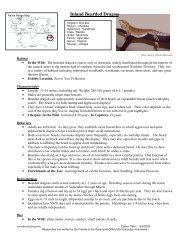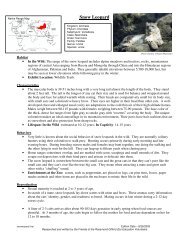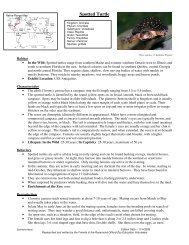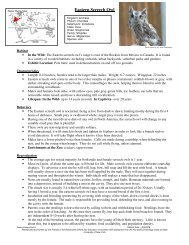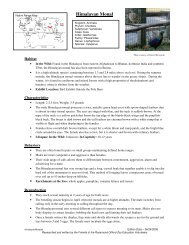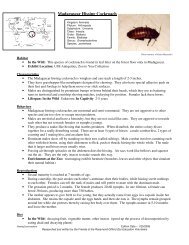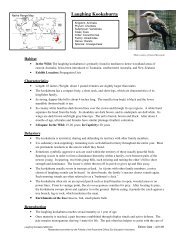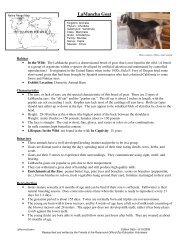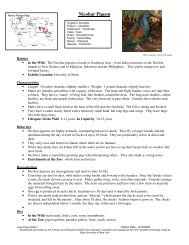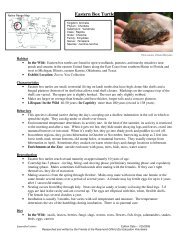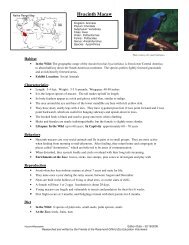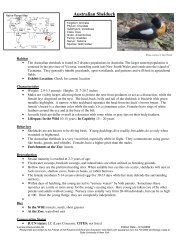African Pygmy Hedgehog - Rosamond Gifford Zoo
African Pygmy Hedgehog - Rosamond Gifford Zoo
African Pygmy Hedgehog - Rosamond Gifford Zoo
You also want an ePaper? Increase the reach of your titles
YUMPU automatically turns print PDFs into web optimized ePapers that Google loves.
Native Range Map<strong>African</strong> <strong>Pygmy</strong> <strong>Hedgehog</strong>Kingdom: AnimaliaPhylum: ChordataSubphylum: VertebrataClass: MammaliaOrder: ErinaceomorphaFamily: ErinaceidaeGenus: AtelerixSpecies: albiventrisHabitatPhoto courtesy of Karen Marzynski• In the Wild: <strong>African</strong> pygmy hedgehogs are found in scattered populations from Senegal in westernAfrica to southern Somalia and Tanzania on the continent’s eastern edge. Their habitats are semiaridareas and dry savannahs.• Exhibit Location: <strong>Zoo</strong> to You CollectionCharacteristics• Length: 6-8 inches; Weight: 18-25 ouncesFemales are typically larger than males.• <strong>African</strong> pygmy hedgehogs have long, rather pointed pinkish-brown snouts, with moist, dark noses.They have round, dark eyes, oval brownish ears, and short, white hair on their brows, cheeks, andbellies. The hairs on their backs and sides are modified into ½-1 inch long, un-barbed spines.• Their back feet have only 4 toes; their front feet have 5.• Though they have reasonably good eyesight with some degree of color vision, they depend far more ontheir excellent hearing and sense of smell that can detect prey 2 inches or more below ground.• Lifespan: In the Wild 2-3 years; In Captivity 8-10 yearsBehaviors• <strong>African</strong> pygmy hedgehogs are solitary and territorial. They find shelter in and under logs, rocks, rootsof trees and brush piles, in termite mounds, in burrows, and under buildings.• They start foraging at dusk and continue through most of the night, then return to their burrows for theday.• <strong>Hedgehog</strong>s have a unique muscle, called the orbicularis panniculi, circling their body under the edge oftheir spiny coat. A frightened hedgehog can roll into a ball and draw the edges of its spiny coat togetherlike a drawstring purse, with its head, belly, and feet tucked inside.• Vocalizations include chirps, chuffs, hisses, and growls that increase with agitation. When fighting orangry they twitter loudly, and if hurt or badly frightened they scream.• When encountering a predator, its standard defensive reaction is to tense up all the muscles on its backto cause its spines to stand erect, and then roll into a ball protecting its limbs and head. If it is harassedfurther, it will twitch in an attempt to jab spines into the predator and make snuffling/grunting noises.Its spines are not released into the skin of an attacker, as those of a porcupine.• During the dry season when insects are scarce, they aestivate, or become dormant, and live off theirstored fat.• Enrichments at the <strong>Zoo</strong>: exercising in playpen, handling by keepers<strong>African</strong><strong>Pygmy</strong><strong>Hedgehog</strong>.km Edition Date – 06/12/2008Researched and written by the Friends of the <strong>Rosamond</strong> <strong>Gifford</strong> <strong>Zoo</strong> Education Volunteers
ReproductionDiet• <strong>Hedgehog</strong>s become sexually mature at 2 months of age.• Females ovulate when the conditions are right --- which is typically during the rainy season when foodis abundant.• The male courts the female by running circles around her, twittering, growling, and snorting. Duringcopulation, he secrets a waxy plug that prevents other males from mating with her.• Gestation is 30-40 days. In the spring after hibernation, usually 3-4 (sometimes up to 10) young areborn alive. The mother licks them clean and eats the afterbirth.• Newborns are blind and weigh about 0.35 ounces. They have soft, white spines at birth. Born withedema (excessive amount of watery fluid in their cells, tissues, or body cavities), their skin is swollenand covers the soft spines. After a few days, the young reabsorb the fluid, exposing the spines. Theireyes open in 8-18 days.• At 2 weeks, they can roll up. At 6 weeks, they can travel short distances with mom. Nursing stops at40-45 days, and they leave mom and siblings shortly thereafter.• In the Wild: worms, snails, arthropods, frogs, lizards, snakes, eggs, nestling birds, small mammals,carrion, fruits, seeds, peanuts, fungi, roots• At the <strong>Zoo</strong>: dry hedgehog food pellets, mealworms, cricketsConservation Status• IUCN status Lower Risk; CITES Appendix: not listed• Due to their popularity as pets, collecting them from the wild is no longer allowed.• Due to their extensive range and stable wild population, the species holds no particular conservationstatus.• Predators: Verreaux eagle owls, honey badgers, jackels, wild dogsDid You Know?/Fun Facts• <strong>Hedgehog</strong>s consume about 1/3 of their body weight at night.• They lick and chew objects with unfamiliar odors or that possess bothersome substances, producingquantities of foamy saliva that they spread over their spines. This is believed to deter predators and isknown as “self-annointing.”• <strong>African</strong> pygmy hedgehogs are also known as “4-toed hedgehogs.”• Researchers at 2 universities have discovered that the blood of both the European and <strong>African</strong>hedgehogs contains a lipoprotein identical to one of those found in human blood. This lipoproteincontributes to the formation of clots that cause heart attacks. <strong>Hedgehog</strong>s may eventually contribute asolution to a human health problem.Sources:• Busch Entertainment Corporation, <strong>African</strong> hedgehog. Retrieved June 8, 2008, from SeaWorld/BuschGardens ANIMALS Web site: http://www.seaworld.org/animal-info/animalbytes/animalia/eumetazoa/coelomates/deuterostomes/chordata/craniata/mammalia/insectivora/africanhedgehog.htm• Elmwood Park <strong>Zoo</strong>, Animal profiles: <strong>African</strong> pygmy hedgehog. Retrieved May 18, 2008, fromElmwood Park <strong>Zoo</strong> Web site:http://www.elmwoodparkzoo.org/animals/animalProfiles/mammals/hedgehog.html• Nichols, J. 1999. “Atelerix albiventris” (on-line), Animal Diversity Web. Accessed January 29, 2008 athttp://animaldiversity.ummz.umich.edu/site/accounts/information/Atelerix_albiventris.html<strong>African</strong><strong>Pygmy</strong><strong>Hedgehog</strong>.km Edition Date – 06/12/2008Researched and written by the Friends of the <strong>Rosamond</strong> <strong>Gifford</strong> <strong>Zoo</strong> Education Volunteers
• Wrobel, D., & Brown, D.V.M., S.A. (1997). An owner's guide to a happy healthy pet: The hedgehog.New York: Howell Book House.<strong>African</strong><strong>Pygmy</strong><strong>Hedgehog</strong>.km Edition Date – 06/12/2008Researched and written by the Friends of the <strong>Rosamond</strong> <strong>Gifford</strong> <strong>Zoo</strong> Education Volunteers



